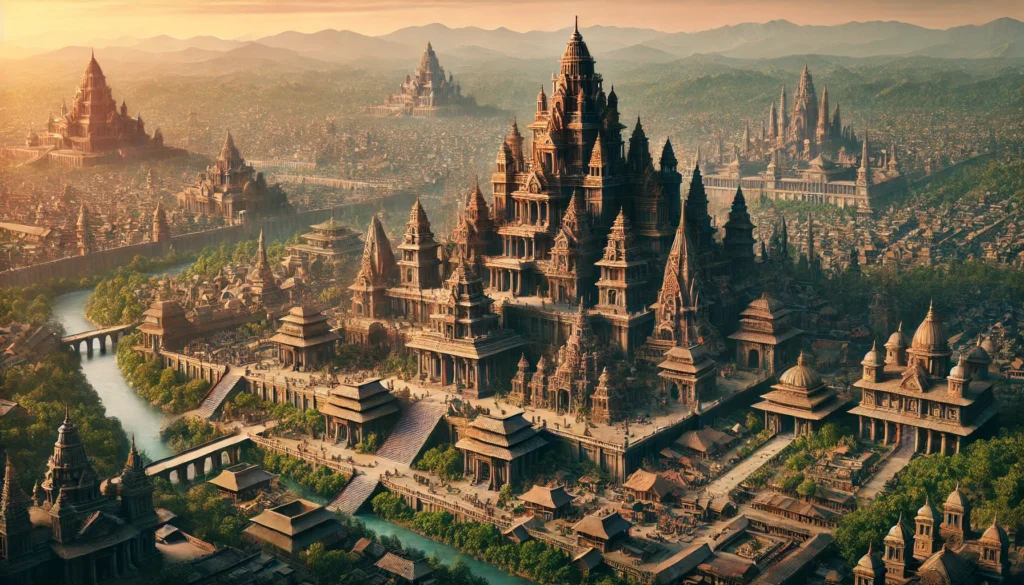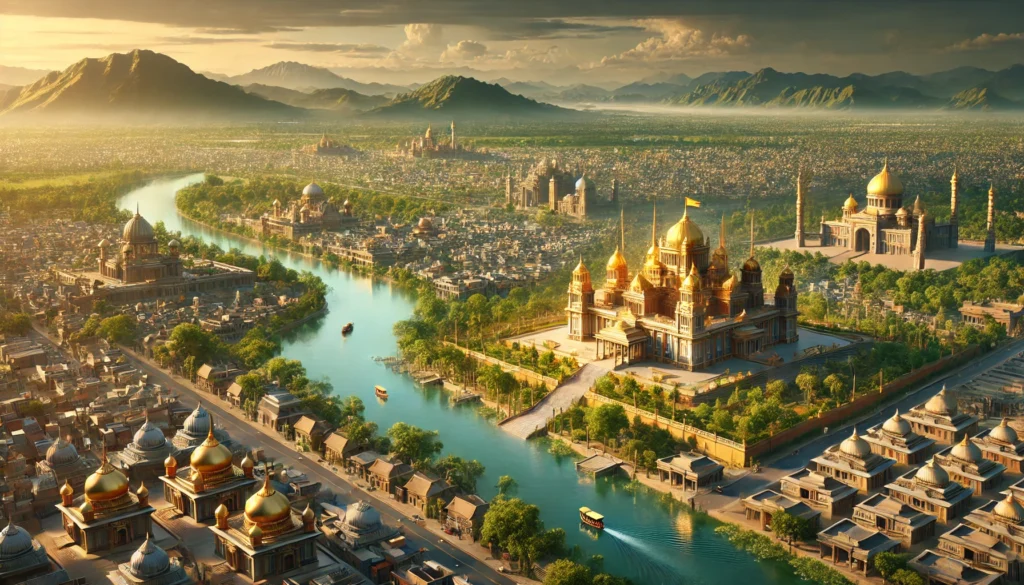India, with its ancient heritage and vibrant mythology, holds secrets of civilizations that thrived millennia ago. Among these secrets are the “India’s Hidden Cities,” mysterious urban centers mentioned in epics, scriptures, and oral traditions. These cities—while often wrapped in the mystique of mythology—offer profound insights into the history, culture, and urban ingenuity of ancient India. Combining archaeology and scriptural accounts, their exploration reveals a captivating blend of myth, history, and Vedic mysteries.

India’s Hidden Cities 1. Dwarka: The Submerged City of Krishna
Dwarka in Mythology
Often referred to as the “Golden City,” Dwarka holds a central place in Indian mythology. According to the Mahabharata and Harivamsa Purana, Dwarka was built by Lord Krishna on the western coast of India. Known for its opulent architecture and intricate planning, it was said to have been submerged in the ocean after Krishna’s departure from Earth.
“व्यापी सेन स्थली हृद्यमानमुपपापम्।” – Mahabharata, Sabha Parva 38.21
(“The city of Dwarka was golden and magnificent, created by divine hands.”)
Role in the Mahabharata
Dwarka served as Krishna’s stronghold and a sanctuary for his people during tumultuous times. Described as a fortified city with grand palaces made of gold and silver, it featured beautifully designed streets, water reservoirs, and advanced governance—an embodiment of Vedic town planning principles. Its strategic location made it a hub for maritime trade and diplomacy, and its spiritual significance attracted scholars and pilgrims alike.
Underwater Archaeological Discoveries
Modern archaeology has unveiled remnants of structures off the coast of Gujarat, including walls, pillars, and artifacts that align with the Mahabharata’s descriptions. Radiocarbon dating suggests some structures are over 9,000 years old, raising intriguing questions about Dwarka’s historicity. Artifacts like pottery and semi-precious stone beads reveal a thriving trade network. These discoveries bring the legend of Dwarka closer to historical reality, showcasing the ingenuity of ancient Indian civilizations.
India’s Hidden Cities 2. Hastinapura: Rediscovering the Kuru Dynasty’s Capital
Historical Accounts in the Mahabharata
Hastinapura, the illustrious capital of the Kuru dynasty, is prominently featured in the Mahabharata. Ruled by legendary kings like Dhritarashtra, Pandu, and Yudhishthira, it was a city of palaces, temples, and bustling marketplaces. The epic portrays Hastinapura as a hub of learning and strategy, with sages and warriors contributing to its prominence.
Archaeological Findings
Excavations near Meerut have uncovered artifacts from the Painted Grey Ware culture (1200-600 BCE), often linked to the Mahabharata’s timeline. Discoveries of ancient fortifications and advanced drainage systems highlight Hastinapura’s planning and resilience. These findings substantiate the Mahabharata’s descriptions, connecting mythology with tangible history.
Legacy and Decline
Hastinapura’s decline, possibly due to Ganga River flooding and political upheavals, marked the end of its golden era. Yet, its legacy persists as a symbol of dharma and the cyclical nature of time. Today, Hastinapura is a revered pilgrimage site, connecting devotees with its storied past.

Ayodhya: The Eternal City of Rama
Ayodhya in the Ramayana
Ayodhya, the birthplace of Lord Rama, is celebrated in the Ramayana as a utopian capital. Its name, meaning “invincible,” reflects its grandeur and prosperity. The epic describes it as a city of wide streets, lush greenery, and harmonious social structures under the righteous rule of King Dasharatha and later, Lord Rama.
“पुर्नम् च सहस्य राज्य म्रदुन्या” – Valmiki Ramayana, Ayodhya Kanda 5.5
(“Ayodhya stood as an unparalleled realm of prosperity and justice.”)
Modern-Day Ayodhya and Archaeological Significance
Excavations in Ayodhya have revealed remnants of ancient structures and artifacts that align with its legendary past. The construction of the Ram Mandir and ongoing archaeological studies continue to spotlight Ayodhya’s significance in history and spirituality.
Socio-Religious Importance
Ayodhya inspires millions as a symbol of dharma, devotion, and governance rooted in righteousness. Festivals like Ram Navami celebrate its legacy, uniting devotees worldwide.

Other Mysterious Cities
Indraprastha
Established by the Pandavas, Indraprastha was a marvel of urban planning, located near modern Delhi. Known for its magical Sabha (assembly hall) designed by Maya Danava, it exemplified architectural ingenuity.
Ujjain
A center of learning and spirituality, Ujjain was associated with astronomical advancements and scholars like Varahamihira. Its importance as a cultural hub endures through the Kumbh Mela.
Pushkar
Mentioned in the Rigveda, Pushkar is known for its sacred lake and temples, blending natural and spiritual landscapes central to Vedic traditions.
Vedic Knowledge and Urban Planning
Ancient Indian texts like the Arthashastra and Vastu Shastra reveal advanced urban planning principles:
- Zoning: Residential, commercial, and sacred areas were meticulously divided.
- Water Management: Sustainable reservoirs and canals ensured water supply.
- Green Spaces: Gardens and open areas promoted ecological balance.
- Infrastructure: Well-planned roads facilitated trade and accessibility.
Modern Relevance
These principles offer timeless lessons for contemporary city planning, emphasizing sustainability and harmony with nature—a legacy embodied by cities like Dwarka and Hastinapura.
The Myths and Science Connection
Perspectives from Archaeology
Discoveries like the ruins of Dwarka and Hastinapura challenge conventional timelines, urging scholars to re-evaluate ancient history. These findings highlight the technological prowess of ancient civilizations.
Astrophysics and Ancient Narratives
References to celestial events in texts like the Mahabharata align with modern astronomical analyses, revealing a sophisticated understanding of the cosmos in Vedic times.
Conclusion
Exploring the “Lost Cities of Ancient India” unravels a tapestry of myth, history, and advanced knowledge. These cities not only shaped India’s cultural and spiritual heritage but also demonstrated unparalleled urban ingenuity. By delving into their stories, we bridge the gap between past and present, drawing inspiration for sustainable solutions and harmonious living.
FAQ Section
Where are the remains of Dwarka located?
The remains of Dwarka are underwater off the coast of Gujarat, near the Gulf of Khambhat.
What is the historical evidence for Hastinapura?
Artifacts linked to the Painted Grey Ware culture have been discovered near Meerut, supporting its historical existence.
How do Vedas describe urban life?
The Vedas emphasize harmonious living with nature, sustainable practices, and advanced infrastructure in urban centers.
Are there connections between these cities and time travel?
While speculative, advanced astronomical knowledge in Vedic texts hints at an understanding of time cycles, akin to modern concepts of time travel.
Exploring these ancient cities invites us to reconnect with a legacy of innovation, spirituality, and resilience, proving that history and mythology often share the same foundation.
